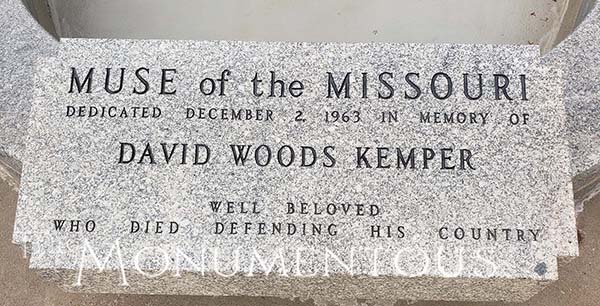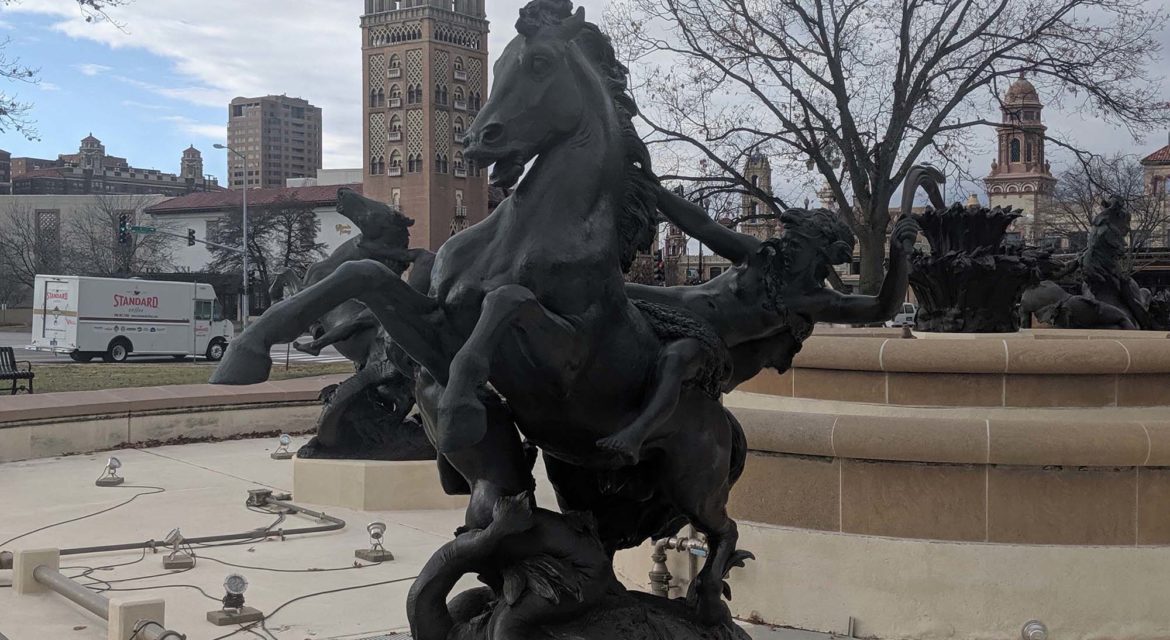 While other cities across the world have numerous and notable fountains, only one city has become known as the “City of Fountains”. Kansas City, Missouri features fountains of all sizes depicting people, animals, mythological subjects and more. These fountains have helped to form an identity and culture for Kansas City that continues to be cultivated by residents and tourists to positively impact the region.
While other cities across the world have numerous and notable fountains, only one city has become known as the “City of Fountains”. Kansas City, Missouri features fountains of all sizes depicting people, animals, mythological subjects and more. These fountains have helped to form an identity and culture for Kansas City that continues to be cultivated by residents and tourists to positively impact the region.

“More Fountains Than Rome”
 Kansas City’s first fountains date back to the late 1800s, when the city was being imagined as a place that could contain “more boulevards than Paris, more fountains than Rome.” At first, the only purpose of the fountains was to provide water for thirsty horses and dogs, but that quickly changed as they were seen as a way to beautify the city or memorialize a person or event. Eventually, sculptures were integrated into fountain designs to both beautify properties and add distinction.
Kansas City’s first fountains date back to the late 1800s, when the city was being imagined as a place that could contain “more boulevards than Paris, more fountains than Rome.” At first, the only purpose of the fountains was to provide water for thirsty horses and dogs, but that quickly changed as they were seen as a way to beautify the city or memorialize a person or event. Eventually, sculptures were integrated into fountain designs to both beautify properties and add distinction.
The fountains range in everything from age to size to subject. While the Women’s Leadership Fountain is the oldest working fountain in the city, the J.C. Nichols Memorial Fountain is the best-known and most-photographed of all of the city’s fountains. The figures originally adorned a mansion in New York but were brought to Kansas City in 1951 and dedicated in 1960.
 Elsewhere, the Henry Wollman Bloch Fountain features 232 jets arranged in three concentric rings within an ellipse of black granite. Sitting between Union Station and the Liberty Memorial, it’s difficult to miss, the same of which cannot be said for fountains like the Brush Creek Fountains. No matter the size or type though, each of the official and unofficial fountains have helped to define “The City of Fountains”, which is far more than a nickname for Kansas City.
Elsewhere, the Henry Wollman Bloch Fountain features 232 jets arranged in three concentric rings within an ellipse of black granite. Sitting between Union Station and the Liberty Memorial, it’s difficult to miss, the same of which cannot be said for fountains like the Brush Creek Fountains. No matter the size or type though, each of the official and unofficial fountains have helped to define “The City of Fountains”, which is far more than a nickname for Kansas City.
Every year in early April, Fountain Day occurs to celebrate all of the publicly operated fountains return to life. It’s a day that represents a great source of pride for residents and attracts visitors from all over the region, highlighting the many experiences people can have all across the “City of Fountains.”

The Fountain Culture of Kansas City
 Some fountains have developed a distinct identity beyond being part of the “City of Fountains”. That’s what happened with the Firefighters Fountain and Memorial with its ties to the history and culture of the city. Members of the Kansas City Fire Department gather at the site to remember the loss of life, illustrating what it can mean when a monument combines history and community.
Some fountains have developed a distinct identity beyond being part of the “City of Fountains”. That’s what happened with the Firefighters Fountain and Memorial with its ties to the history and culture of the city. Members of the Kansas City Fire Department gather at the site to remember the loss of life, illustrating what it can mean when a monument combines history and community.
Additionally, Muse of the Missouri, which depicts a goddess bestowing her interest and guidance on the Missouri River, has taken on additional meaning. The City of Fountains Foundation holds an endowment for this fountain which was dedicated to David Woods Kemper, who was killed in the last days of World War II while serving as a platoon commander in the European theater.
In 1992, the city added “City of Fountains” to its official corporate seal that can be found in numerous places throughout the city. That logo appears on many items for sale across the city as well, showcasing how these fountains are influencing the culture and economy of the city.

Cultivating an Identity

Numerous businesses and events utilize the ubiquitous fountains as an essential part of their advertisements, to the point that auto dealerships have promoted a “car fountain”. Whether they’re promoting an event or simply using the fountains to tie their brand to the city, the identity the fountains represent for the city has become instantly recognizable to everyone. It’s why the fountains themselves are an essential part of items that are for sale as well as central points of interest on maps and guides to the city.
KC Parks maintains 48 fountains with the city, but there are 200 officially registered fountains in the metropolitan Greater Kansas City area. However, that number does not include the many fountains at corporation and sub-division entrances, office atriums, private gardens and homes. Numerous businesses throughout Kansas City have installed fountains to keep raising the unofficial total and further cultivate the identity of the “City of Fountains”.
This identity has created a legacy that people can be part of in various ways. Whether it’s a business that installs a fountain or a tourist that tries to see them all, the fountains of Kansas City have enabled everyone to experience the city in a unique way that will continue to generate interest and activity.
A Legacy for Kansas City
 Fountain season begins in April and runs through early November, but the presence and importance of the fountains to Kansas City remain throughout the year. By creating an identity that both residents and visitors can experience and engage with in distinct ways, the “City of Fountains” showcases what it means for a city to embrace and cultivate a legacy.
Fountain season begins in April and runs through early November, but the presence and importance of the fountains to Kansas City remain throughout the year. By creating an identity that both residents and visitors can experience and engage with in distinct ways, the “City of Fountains” showcases what it means for a city to embrace and cultivate a legacy.


